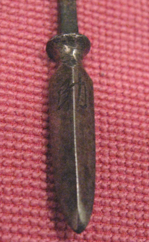 Maybe it’s true that every boy needs a hobby, but I don’t really have a proper one. No time. I do have interests, often sparked by research I’ve done for writing-related reasons. One of them is Japanese arms and armor before the Meiji Restoration. My most recent acquisition is a togari-ya style yanone, or arrowhead, probably from the Edo period(early 17th-mid 19th C), signed “Sukefusa.” Here’s where it gets interesting (to me, anyway. YMMV)—just because the arrowhead is signed with the name Sukefusa, it doesn’t mean it was actually made by a smith with the art name Sukefusa. Japanese smiths had a long history of signing the names of more famous smiths to the weapons they made, for the obvious reason that a more famous smith could command a higher price. Also, sometimes the samurai liked to carry a “famous name” weapon even if they knew it wasn’t legit, because such names were thought to bring luck. Weapons with false signatures are known as “Gimei” or “false name.” For example, I own a sword blade signed Ichinohira Yasuyo, who was a famous smith from Satsuma province in the 18th century. The sword was almost certainly not made by Yasuyo, and probably not even in Satsuma province. So how does one tell if the mei (name/signature) on the weapon is real? A proper expert can look at a sword blade and not only tell you roughly when it was made, but what school/tradition of swordsmiths made it, and sometimes the particular smith. The mei would be the last thing they look at, not the first, and then the mei would be compared to known signatures by that smith. Only then would there be a judgment on the authenticity of the signature.
Maybe it’s true that every boy needs a hobby, but I don’t really have a proper one. No time. I do have interests, often sparked by research I’ve done for writing-related reasons. One of them is Japanese arms and armor before the Meiji Restoration. My most recent acquisition is a togari-ya style yanone, or arrowhead, probably from the Edo period(early 17th-mid 19th C), signed “Sukefusa.” Here’s where it gets interesting (to me, anyway. YMMV)—just because the arrowhead is signed with the name Sukefusa, it doesn’t mean it was actually made by a smith with the art name Sukefusa. Japanese smiths had a long history of signing the names of more famous smiths to the weapons they made, for the obvious reason that a more famous smith could command a higher price. Also, sometimes the samurai liked to carry a “famous name” weapon even if they knew it wasn’t legit, because such names were thought to bring luck. Weapons with false signatures are known as “Gimei” or “false name.” For example, I own a sword blade signed Ichinohira Yasuyo, who was a famous smith from Satsuma province in the 18th century. The sword was almost certainly not made by Yasuyo, and probably not even in Satsuma province. So how does one tell if the mei (name/signature) on the weapon is real? A proper expert can look at a sword blade and not only tell you roughly when it was made, but what school/tradition of swordsmiths made it, and sometimes the particular smith. The mei would be the last thing they look at, not the first, and then the mei would be compared to known signatures by that smith. Only then would there be a judgment on the authenticity of the signature.
 Which brings me back to the yanone. Another one turned up about five years ago on a discussion group dedicated to this sort of thing. I’ve compared the signature on mine to that one, and I’m satisfied that they were done by the same smith. Considering the difficulty of getting information on him, odds are this smith is fairly obscure, and therefore less likely to have his mei copied. The catch is that no one’s sure who he is. As with most smith names, more than one smith worked under the name “Sukefusa,” the most famous one dating from the 13th century. I’m reasonably certain this arrowhead was not made by that one. The MMA in NY has a yanone in its collection also signed Sukefusa, which they date from the 18th century. Problem is, they don’t have a picture of it online, so I can’t compare this signature to that one. If I’m ever in New York, I’ll have to go look. In the meantime, and as time permits, it’s like doing detective work. I want to know who this particular Sukefusa was, where he worked, what other things he did.
Which brings me back to the yanone. Another one turned up about five years ago on a discussion group dedicated to this sort of thing. I’ve compared the signature on mine to that one, and I’m satisfied that they were done by the same smith. Considering the difficulty of getting information on him, odds are this smith is fairly obscure, and therefore less likely to have his mei copied. The catch is that no one’s sure who he is. As with most smith names, more than one smith worked under the name “Sukefusa,” the most famous one dating from the 13th century. I’m reasonably certain this arrowhead was not made by that one. The MMA in NY has a yanone in its collection also signed Sukefusa, which they date from the 18th century. Problem is, they don’t have a picture of it online, so I can’t compare this signature to that one. If I’m ever in New York, I’ll have to go look. In the meantime, and as time permits, it’s like doing detective work. I want to know who this particular Sukefusa was, where he worked, what other things he did.
The arrowhead is a lovely object just as an object, but that’s only half the fun.
